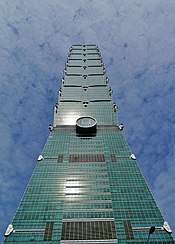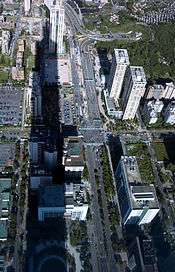Taipei 101
The Taipei 101 (Chinese: 台北101; pinyin: Táiběi yī líng yī; stylized as TAIPEI 101),[1] formerly known as the Taipei World Financial Center (臺北國際金融中心), is a supertall skyscraper designed by C.Y. Lee and C.P. Wang in Xinyi, Taipei, Taiwan. This building was officially classified as the world's tallest from its opening in 2004 until the 2010 completion of the Burj Khalifa in Dubai, United Arab Emirates.
| Taipei 101 | |
|---|---|
台北101 | |
.jpeg) | |

| |
| Former names | Taipei World Financial Center |
| Record height | |
| Tallest in the world from 2004 to 2010[I] | |
| Preceded by | Petronas Towers |
| Surpassed by | Burj Khalifa |
| General information | |
| Status | Complete |
| Type | Skyscraper |
| Architectural style | Postmodernism |
| Address | No. 7, Section 5, Xinyi Road, Xinyi District |
| Town or city | Xinyi District, Taipei |
| Country | Taiwan |
| Coordinates | 25°2′1″N 121°33′54″E |
| Construction started | 31 July 1999[1] |
| Completed | 31 December 2004[1] |
| Cost | NT$58 billion USD1.895 billion |
| Owner | Taipei Financial Center Corporation[2] |
| Landlord | Taipei City Government |
| Height | |
| Architectural | 509.2 m (1,671 ft) [3] |
| Tip | 509.2 m (1,671 ft)[3] |
| Roof | 449.2 m (1,474 ft)[3] |
| Top floor | 439.2 m (1,441 ft)[3] |
| Observatory | 449.2 m (1,474 ft)[3] |
| Technical details | |
| Floor count | 101[2] |
| Floor area | 412,500 m2 (4,440,100 sq ft)[4] |
| Lifts/elevators | 61 |
| Design and construction | |
| Architect | C.Y. Lee & C.P. Wang |
| Main contractor | KTRT Joint Venture[5][6]
|
| Awards and prizes | Existing Buildings, LEED Platinum O+M |
| Website | |
| www | |
| References | |
| [1][3][2][7][8] | |
| Taipei 101 | |||||||||||||||||||||||||||||||||||||||||||||
|---|---|---|---|---|---|---|---|---|---|---|---|---|---|---|---|---|---|---|---|---|---|---|---|---|---|---|---|---|---|---|---|---|---|---|---|---|---|---|---|---|---|---|---|---|---|
| Chinese | 台北101 | ||||||||||||||||||||||||||||||||||||||||||||
| Literal meaning | "Tai[wan] North 101" | ||||||||||||||||||||||||||||||||||||||||||||
| |||||||||||||||||||||||||||||||||||||||||||||
| Taipei World Financial Center | |||||||||||||||||||||
|---|---|---|---|---|---|---|---|---|---|---|---|---|---|---|---|---|---|---|---|---|---|
| Traditional Chinese | 臺北國際金融中心 | ||||||||||||||||||||
| Simplified Chinese | 台北国际金融中心 | ||||||||||||||||||||
| |||||||||||||||||||||
Its elevators, capable of traveling 60.6 km/h (37.7 mph) and used to transport passengers from the 5th to 89th floor in 37 seconds, set new records upon completion.[9] In 2011 Taipei 101 received a Platinum rating under the LEED certification system to become the tallest and largest green building in the world.[10][11] The structure regularly appears as an icon of Taipei in international media, and the Taipei 101 fireworks displays are a regular feature of New Year's Eve broadcasts.
Taipei 101's postmodernist architectural style evokes traditional Asian aesthetics in a modern structure employing industrial materials. Its design incorporates a number of features that enable the structure to withstand the Pacific Rim's earthquakes and the region's tropical storms. The tower houses offices and restaurants as well as both indoor and outdoor observatories. The tower is adjoined by a multilevel shopping mall that has the world's largest ruyi symbol as an exterior feature.
Taipei 101 is owned by Taipei Financial Center Corporation. The skyscraper opened on 31 December 2004 to celebrate New Year's Eve.
Features
Height
Taipei 101 comprises 101 floors above ground, as well as 5 basement levels. It was not only the first building in the world to break the half-kilometer mark in height,[3] but also the world's tallest building from 31 March 2004 to 10 March 2010.[12][13] As of 18 April 2019, it is still the world's largest and highest-use green building.[10][11]
Upon its completion, Taipei 101 was the world's tallest inhabited building, at 509.2 m (1,671 ft) as measured to its height architectural top (spire), exceeding that of the Petronas Towers, which were previously the tallest inhabited skyscraper at 451.9 m (1,483 ft). The height to the top of the roof, at 449.2 m (1,474 ft), and highest occupied floor, at 439.2 m (1,441 ft), surpassed the previous records of 442 m (1,450 ft) and 412.4 m (1,353 ft), respectively; the Willis Tower had previously held that distinction.[3][14][15][16][17] It also surpassed the 85-story, 347.5 m (1,140 ft) Tuntex Sky Tower in Kaohsiung as the tallest building in Taiwan and the 51-story, 244.15 m (801 ft) Shin Kong Life Tower as the tallest building in Taipei.[18][19] Taipei 101 claimed the official records for the world's tallest sundial and the world's largest New Year's Eve countdown clock.[20]
Various sources, including the building's owners, give the height of Taipei 101 as 508 m (1,667 ft), roof height and top floor height as 448 m (1,470 ft) and 438 m (1,437 ft). This lower figure is derived by measuring from the top of a 1.2 m (4 ft) platform at the base.[1][3] CTBUH standards, though, include the height of the platform in calculating the overall height, as it represents part of the man-made structure and is above the level of the surrounding pavement.[14][16][15][17] Taipei 101 displaced the Petronas Towers as the tallest building in the world by 57.3 m (188 ft).[16][21] The record it claimed for greatest height from ground to pinnacle was surpassed by the Burj Khalifa in Dubai, which is 829.8 m (2,722 ft) in height. Taipei 101's records for roof height and highest occupied floor briefly passed to the Shanghai World Financial Center in 2008, which in turn yielded these records as well to the Burj.[14][16]
Structural design
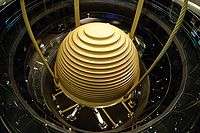

The Taipei 101 is designed to withstand typhoon winds and earthquake tremors that are common in the area in the east of Taiwan. Evergreen Consulting Engineering, the structural engineer, designed Taipei 101 to withstand gale winds of 60 meters per second (197 ft/s), (216 km/h or 134 mph), as well as the strongest earthquakes in a 2,500-year cycle.[22]
Taipei 101 was designed to be flexible as well as structurally resistant, because while flexibility prevents structural damage, resistance ensures comfort both for the occupants and for the protection of the glass, curtain walls, and other features.[23] Most designs achieve the necessary strength by enlarging critical structural elements such as bracing. Because of the height of Taipei 101, combined with the surrounding area's geology—the building is located just 660 ft (200 m) away from a major fault line[24]—Taipei 101 used high-performance steel construction and 36 columns, including eight "mega-columns" packed with 10,000 psi (69 MPa) concrete.[25] Outrigger trusses, located at eight-floor intervals, connect the columns in the building's core to those on the exterior.[26]
These features, combined with the solidity of its foundation, made Taipei 101 one of the most stable buildings ever constructed. The foundation is reinforced by 380 piles driven 80 m (262 ft) into the ground, extending as far as 30 m (98 ft) into the bedrock. Each pile is 1.5 m (5 ft) in diameter and can bear a load of 1,000–1,320 metric tons (1,100–1,460 short tons).[25] During construction, on 31 March 2002, a 6.8-magnitude earthquake rocked Taipei; two construction cranes from the 56th floor, the highest floor at the time, toppled. Five people died in the accident, but an inspection showed no structural damage to the building, and construction soon resumed.[26]
RWDI designed a 660 metric tons (728 short tons)[27][28][29] steel pendulum that serves as a tuned mass damper, at a cost of NT$132 million (US$4 million).[30] Suspended from the 92nd to the 87th floor, the pendulum sways to offset movements in the building caused by strong gusts. Its sphere, the largest damper sphere in the world, consists of 41 circular steel plates of varying diameters, each 125 mm (4.92 in) thick, welded together to form a 5.5 m (18 ft) diameter sphere. Two additional tuned mass dampers, each weighing 6 metric tons (7 short tons), are installed at the tip of the spire which help prevent damage to the structure due to strong wind loads.[30][31] On 8 August 2015, strong winds from Typhoon Soudelor swayed the main damper by 1 meter (39 in) – the largest movement ever recorded by the damper.[32][33]
The damper has become such a popular tourist attraction, the city contracted Sanrio to create a mascot: the Damper Baby. Four versions of the Damper Baby: "Rich Gold", "Cool Black", "Smart Silver" and "Lucky Red" were designed and made into figurines and souvenirs sold in various Taipei 101 gift shops. Damper Baby, with its cute all-ages appeal, has become a popular local icon, with its own comic book and website.[34][35][36]
Structural facade
Taipei 101's characteristic blue-green glass curtain walls are double paned and glazed, offer heat and UV protection sufficient to block external heat by 50 percent, and can sustain impacts of 7 metric tons (8 short tons).[22] The facade system of glass and aluminum panels installed into an inclined movement-resisting lattice contributes to overall lateral rigidity by tying back to the mega-columns with one-story high trusses at every eighth floor. This facade system is therefore able to withstand up to 95 mm (4 in) of seismic lateral displacements without damage.[37]The facade system is also known as a Damper.
The original corners of the cade were tested at RWDI in Ontario. A simulation of a 100-year storm at RWDI revealed a vortex that formed during a 3-second 105 miles per hour (169 km/h) wind at a height of 10 meters, or equivalent to the lateral tower sway rate causing large crosswind oscillations. A double chamfered step design was found to dramatically reduce this crosswind oscillation, resulting in the final design's "double stairstep" corner facade.[38] Architect C.Y. Lee also used extensive facade elements to represent the symbolic identity he pursued. These facade elements included the green tinted glass for the indigenous slender bamboo look, eight upper outwards inclined tiers of pagoda each with eight floors, a Ruyi and a money box symbol between the two facade sections among others.[39]
Taipei 101's own roof and facade recycled water system meets 20 to 30 percent of the building's water needs. In July 2011, Taipei 101 was certified "the world's tallest green building" under LEED standards.[40]
Symbolism
The height of 101 floors commemorates the renewal of time: the new century that arrived as the tower was built (100+1) and all the new years that follow (1 January = 1-01). It symbolizes lofty ideals by going one better on 100, a traditional number of perfection. The number also evokes the binary numeral system used in digital technology.[25]
The main tower features a series of eight segments of eight floors each. In Chinese-speaking cultures the number eight is associated with abundance, prosperity and good fortune.[41][42]
The repeated segments simultaneously recall the rhythms of an Asian pagoda (a tower linking earth and sky, also evoked in the Petronas Towers), a stalk of bamboo (an icon of learning and growth), and a stack of ancient Chinese ingots or money boxes (a symbol of abundance). Popular humor sometimes likens the building's shape to a stack of take-out boxes as used in Western-style Chinese food; of course, the stackable shape of such boxes is likewise derived from that of ancient money boxes.[43] The four discs mounted on each face of the building where the pedestal meets the tower represent coins. The emblem placed over entrances shows three gold coins of ancient Chinese design with central holes shaped to imply the Arabic numerals 1-0-1.[25] The structure incorporates many shapes of squares and circles to reach a balance between yin and yang.
Curled ruyi figures appear throughout the structure as a design motif. Though the shape of each ruyi at Taipei 101 is traditional, its rendering in industrial metal is plainly modern. The ruyi is a talisman of ancient origin associated in art with Heavenly clouds. It connotes healing, protection and fulfillment. It appears in celebrations of the attainment of new career heights.[44][45] The sweeping curved roof of the adjoining mall culminates in a colossal ruyi that shades pedestrians.[45] Each ruyi ornament on the exterior of the Taipei 101 tower stands at least 8 m (26 ft) tall.[46]
At night the bright yellow gleam from its pinnacle casts Taipei 101 in the role of a candle or torch upholding the ideals of liberty and welcome. From 6:00 to 10:00 each evening[47] the tower's lights display one of seven colors in the spectrum. The colors coincide with the days of the week:[48]
| Day | Monday | Tuesday | Wednesday | Thursday | Friday | Saturday | Sunday |
|---|---|---|---|---|---|---|---|
| Color | red | orange | yellow | green | blue | indigo | purple |
The adjoining Taipei 101 on the east side connects the landmark further with the symbolism of time. The design of the circular park doubles as the face of a giant sundial. The tower itself casts the shadow to mark afternoon hours for the building's occupants. The park's design is echoed in a clock that stands at its entrance. The clock runs on energy drawn from the building's wind shear.[49]
Taipei 101, like many of its neighboring buildings, exemplifies the influence of feng shui philosophy. An example appears in the form of a large granite fountain at the intersection of Songlian Road and Xinyi Road near the tower's east entrance.[50] A ball at the fountain's top spins toward the tower. As a work of public art the fountain offers a contrast to the tower in texture even as its design echoes the tower's rhythms. The fountain also serves a practical function in feng shui philosophy. A T intersection near the entrance of a building represents a potential drain of positive energy, or ch'i, from the structure and its occupants.[51][52] Placing flowing water at such spots is thought to help redirect the flow of ch'i.[53][54]
Interior
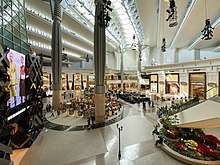

Taipei 101 is the first record-setting skyscraper to be constructed in the 21st century. It exhibits a number of technologically advanced features as it provides a center for business and recreation.[3]
The original 2004 fiber-optic and satellite Internet connections permitted transfer speeds up to a gigabit per second.[23]
The double-deck elevators built by the Japanese Toshiba Elevator and Building Systems Corporation (TELC) set a new record in 2004 with the fastest ascending speeds in the world. At 60.6 kilometers (37.7 mi) per hour, 16.83 m (55.22 ft) per second, or 1010 m/min,[30] the speed of Taipei 101's elevators is 34.7 percent faster than the previous record holders of the Yokohama Landmark Tower elevator, Yokohama, Japan, which reaches speeds of 12.5 m (41 ft) per second (45.0 km/h, 28.0 mi/h). Taipei 101's elevators sweep visitors from the fifth floor to the 89th-floor observatory in only 37 seconds.[55] Each elevator features an aerodynamic body, full pressurization, state-of-the art emergency braking systems, and the world's first triple-stage anti-overshooting system. The cost for each elevator is NT$80 million (US$2.4 million).[56][57][58][59]
A 660 metric tons (728 short tons) tuned mass damper (TMD), located between the 87th and 91st floors,[30] stabilizes the tower against movements caused by high winds.[38] The damper can reduce up to 40 percent of the tower's movements.[60][61] The TMD is visible to all visitors on the 87th through 91st floors.[30]
Two restaurants have opened on the 85th floor: Diamond Tony's, which offers European-style seafood and steak, and Shin Yeh 101 (欣葉), which offers Taiwanese Hokkien cuisine. Occupying all of the 86th floor is Taiwanese restaurant Ding Xian 101.[62] Din Tai Fung, several international dining establishments and retail outlets also operate in the adjoining mall. The multistory retail mall adjoining the tower is home to hundreds of fashionable stores, restaurants, clubs and other attractions. The mall's interior is modern in design even as it makes use of traditional elements. The curled ruyi symbol is a recurring motif inside the mall. Many features of the interior also observe feng shui traditions.[54]
Floor directory
A tenant directory is posted in the first floor's lobby (visible from the Xinyi entrance).
The number 4 is considered an unlucky number in Chinese culture,[42] so what would have been the 44th floor has been replaced by Level 43, with 42A replacing the actual 43 to compensate for the skipped floor number.
As of 1 January 2011, the highest occupied office floor (excluding the observatory and restaurants) was 75. The building appears to be at least 70 percent occupied at this point.
There is a freight elevator that stops at every level from B5 to 91, with a button for every floor.
The 92nd through 100th floors are officially designated as communication floors, although it's unknown if there are any radio or TV stations currently broadcasting from the top of Taipei 101. The 101st floor indoor/outdoor rooftop observatory opened to the public on June 14, 2019.[63]
The top 10 floors are to have stated on their website to contain a radio and television relay station, Emergency system receiving/signaling relay station, telecommunications stations, and an outdoor antenna frame on 96F, which offers power, fire protection, telecom systems, and security related systems, according to their website.
The 101st floor is home to a private VIP club named Summit 101, according to the observatory brochure. Before 2014, no information about this club was ever made public.[64] In 2014, photos of the exclusive club were shown on TV for the first time. A Taipei Financial Center Corporation spokesman said that only foreign dignitaries, Hollywood film actors, and high spenders in the Taipei 101 Mall (over NT $1 million in purchases) had been invited to the VIP club.[65]
Access to the 101st floor requires two elevator transfers on the 89th and 93rd floors, respectively. There is only one service elevator that facilitates access to the top nine floors (93–101). The 101st floor is divided into three levels: 101F (lower), 101MF (mezzanine) and 101RF (roof). The VIP club exists on the lower level, while 101RF, a mechanical floor, provides access to the 60-meter tall spire, which has 24 levels (numbered R1 through R24) that can only be accessed via ladder.
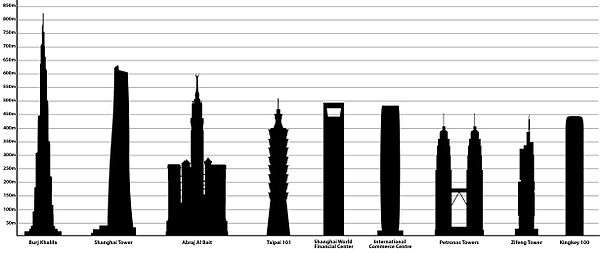
Elevator
The Taipei 101 includes two high-speed observatory elevators manufactured by Toshiba in cooperation with Kone. Their highest speed is 1,010 meters per minute (about 60.6 kilometers per hour). It only takes 37 seconds to travel from the 5th floor to the 89th floor of the skyscraper. In 2016, the title for the fastest elevator was taken away by the Shanghai Tower in Shanghai.[66] Shortly after, the title for the world's fastest elevator was passed on yet again to the Guangzhou CTF Finance Centre.[67]
| 101st floor | Summit 101 (Private VIP Club)[68]/ Outdoor Observatory Deck |
|---|---|
| 92nd – 100th floor | Mechanical |
| 91st floor | Outdoor Observatory Deck |
| 90th floor | Mechanical |
| 88th – 89th floor | Indoor Observatory Deck |
| 87th floor | Mechanical |
| 85th – 86th floor | Observatory Restaurant[2] |
| 82nd floor | Mechanical |
| 74th floor | Mechanical |
| 66th floor | Mechanical |
| 59th – 84th floor | High Zone Office |
| 59th – 60th floor | Sky lobbies |
| 58th floor | Mechanical |
| 50th floor | Mechanical |
| 42nd floor | Mechanical |
| 35th – 58th floor | Mid Zone Office |
| 35th – 36th floor | Sky lobbies / Amenities [2] / Taipei 101 Conference Center[2] |
| 34th floor | Mechanical |
| 25th - 26th floor | Mechanical |
| 17th - 18th floor | Mechanical |
| 9th – 34th floor | Low Zone Office |
| 7th - 8th floor | Mechanical |
| B1 – 5th floor | Taipei 101 Mall[2] / Taipei 101–World Trade Center metro station |
| B5 – B2 | Parking Levels[2] |
Observation Deck

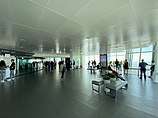
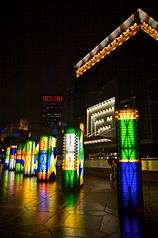
Taipei 101 features an indoor observation deck on the 88th and 89th floors, and two outdoor observation decks (91st floor and 101st floor), all offering 360-degree views and attract visitors from around the world. The Indoor Observatory stands 383.4 m (1,258 ft) above ground, offering a comfortable environment, large windows with UV protection, recorded voice tours in eight languages, and informative displays and special exhibits. Here, one may view the skyscraper's main damper, which is the world's largest and heaviest visible damper, and buy food, drinks and gift items. Two more flights of stairs take visitors up to the Outdoor Observatory. The Outdoor Observatories, at 391.8 m (1,285 ft) and 449.2 m (1,474 ft) above ground,[3][69] is the second-highest observation deck ever provided in a skyscraper and the highest such platform in Taiwan.[18][70]
The Indoor Observatory is open thirteen hours a day (9:00 am–10:00 pm) throughout the week as well as on special occasions; the Outdoor Observatory is open during the same hours as weather permits. Tickets may be purchased on site in the shopping mall (5th floor) or in advance through the Observatory's website.[71] Tickets cost NT$600 (US$19.42, as of 20 October 2018) and allow access to the 88th through 91st floors via high-speed elevator.[72]
The 91st-floor observatory used to be the highest floor that open to the public until June 14, 2019 when it was announced by the building's management team that the 101st floor (at 460m above sea level) will be opened to the general public, with a quota of 36 people per day and is subject to prior booking.[73] To reach the top viewing platform, visitors will first need to reach the 89th floor, and from there, they will need to transfer to two elevators and take stairs from there. As the top observation deck is a small space, it can only accommodate 12 people at a time. Starting Saturday, only three groups of 12 will be allowed on the deck per day, at 40 minutes each.Reservations for the terrace will start on Saturday and tickets are NT$3,000 per person. Those who register before the end of June will receive a nine percent discount. As it is an outdoor viewing platform, it will be necessary to wear safety equipment, including a safety belt, which is buckled to the railing. Visitors will need to walk along the railing and closely follow instructions. Under professional guidance, visitors will be able to enjoy a 360-degree panoramic view of Taipei. The platform will soon undoubtedly become a coveted spot to capture the ultimate souvenir photos of a trip to Taipei. The name of the package tour for the top terrace is "101 Skyline 460" and includes fast transit to the top, exclusive souvenir photos, "cloud coffee," and Taipei 101 souvenir bottled water.
Art
Many works of art appear in and around Taipei 101. These include: German artist Rebecca Horn's Dialog between Yin and Yang in 2002 (steel, iron), American artist Robert Indiana's 1-0 in 2002 and Love in 2003 (aluminum), French artist Ariel Moscovici's Between Earth and Sky in 2002 (rose de la claret granite), Taiwanese artist Chung Pu's Global Circle In 2002 (black granite, white marble), British artist Jill Watson's City Composition in 2002 (Bronze), and Taiwanese artist Kang Mu Hsiang's Infinite Life in 2013 (aluminum).[25] Moreover, the Indoor Observatory hosts a regular series of exhibitions. The artists represented have included Wu Ching (gold sculpture), Ping-huang Chang (traditional painting) and Po-lin Chi (aerial photography).[74]
History
Construction

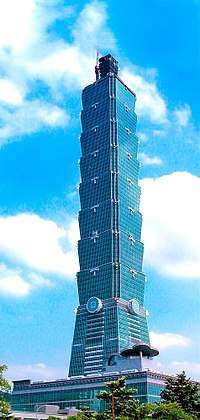
Planning for Taipei 101 began in July 1997[2] during Chen Shui-bian's term as Taipei mayor. Talks between merchants and city government officials initially centered on a proposal for a 66-story tower to serve as an anchor for new development in Taipei's 101 business district. Planners were considering taking the new structure to a more ambitious height only after an expat suggested it, along with many of the other features used in the design of the building. It wasn't until the summer of 2001 that the city granted a license for the construction of a 101-story tower on the site. In the meantime, construction proceeded and the first tower column was erected in the summer of 2000.[2][61]
A major earthquake took place in Taiwan during 31 March 2002 destroying a construction crane at the rooftop, which was at floor number 47. The crane fell down onto the Xinyi Road beneath the tower, crushing several vehicles and causing five deaths – two crane operators and three workers who were not properly harnessed. However, an inspection showed no structural damage to the building, and construction work was able to restart within a week.[26]
Taipei 101's roof was completed three years later on 1 July 2003. Ma Ying-jeou, in his first term as Taipei mayor, fastened a golden bolt to signify the achievement.[3] The formal opening of the tower took place on New Year's Eve 2004. President Chen Shui-bian, Taipei Mayor Ma Ying-jeou and Legislative Speaker Wang Jin-pyng cut the ribbon. Open-air concerts featured a number of popular performers, including singers A-Mei and Stefanie Sun. Visitors rode the elevators to the Observatory for the first time. A few hours later the first fireworks show at Taipei 101 heralded the arrival of a new year.[75][20][76][77]
Chronology
Important dates in the planning and construction of Taipei 101 include the following:[25]
| Date | Event |
|---|---|
| 20 October 1997 | Development and operation rights agreement signed with Taipei City government. |
| 13 January 1999 | Ground-breaking ceremony. |
| 7 June 2000 | First tower column erected. |
| 13 April 2001 | Design change to 509.2 m height approved by Taipei City government. |
| 13 June 2001 | Taipei 101 Mall topped out. |
| 10 August 2001 | Construction license awarded for 101 stories. |
| 31 March 2002 | Partially constructed building survives 6.8 magnitude earthquake undamaged. |
| 13 May 2003 | Taipei 101 Mall obtains occupancy permit. |
| 1 July 2003 | Taipei 101 Tower roof completed. |
| 17 October 2003 | Pinnacle placed. |
| 14 November 2003 | Taipei 101 Mall opens.[2] |
| 15 April 2004 | Council on Tall Buildings and Urban Habitat (CTBUH) certifies Taipei 101 as world's tallest building. |
| 12 November 2004 | Tower obtains occupancy permit. |
| 31 December 2004 | Tower opens to the public.[2] |
| 1 January 2005 | First New Year fireworks show begins at midnight. |
Events

Taipei 101 is the site of many special events. Art exhibits, as noted above, regularly take place in the Observatory. A few noteworthy dates since the tower's opening include these.
On 28 February 2005, Former President of the United States Bill Clinton visited and signed copies of his autobiography.[78] On 19 April 2005, the tower displayed the formula "E=mc2" in lights to celebrate the 100th anniversary of the publication of Einstein's theory of relativity. The display, the largest of 65,000 such displays in 47 countries, was part of the international celebration Physics Enlightens the World.[74] On 20 October 2006, the tower displayed a pink ribbon in lights to promote breast cancer awareness. The ten-day campaign was sponsored by Taipei 101's ownership and Estée Lauder.[74]
On 25 December 2004, French rock and urban climber Alain Robert made an authorized climb to the top of the pinnacle in four hours.[79] On 12 December 2007, Austrian base jumper Felix Baumgartner survived an unauthorized parachute jump from the 91st floor.[80] On 20 November 2005, the First annual Taipei 101 Run Up featured a race up the 2,046 steps from floors 1 to 91. Proceeds were to benefit Taiwan's Olympic teams. The men's race was won by Paul Crake of Australia (10 minutes, 29 seconds), and the women's race by Andrea Mayr of Austria (12 minutes, 38 seconds).[74] On 15 June 2008, Taipei 101 Run Up featured 2,500 participants. The men's race was won by Thomas Dold of Germany (10 minutes, 53 seconds); 2007 champion Marco De Gasperi of Italy finished second and Chen Fu-tsai of Taiwan finished third. The women's race was won by Lee Hsiao-yu of Taiwan (14 minutes, 53 seconds).[81][82] On 6 December 2014, Japanese idol group HKT48 held a small concert on the 91st floor observatory as the premiere of their tour in Taiwan.[83][84]
New Year's Eve fireworks displays
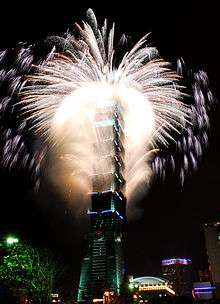
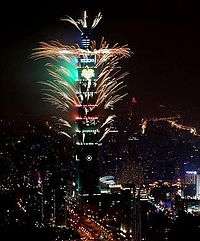
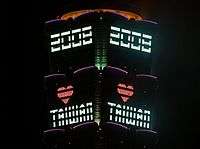
The New Year's Eve show in Taipei is hosted at the Taipei City Hall, which also provides a view of Taipei 101 which is lit up with fireworks. Another popular location for crowds to gather to see the fireworks display is the Sun Yat-sen Memorial Hall. For the first three years (2004–2006), the annual fireworks show at Taipei 101 was preceded by the sequential display of numerals in lights on each section to count down the last eight seconds to midnight. Since 2007 the building has been completely darkened, then fireworks begin to launch sequentially from the lower to upper sections.
- 2003–2004: Building still under construction. Spinning lights on the Outdoor Observatory (floor 91) provided a display of sound and lights, but no fireworks were launched.
- 2004–2005: Grand opening of Taipei 101 celebrated with the first fireworks display. The show lasted 35 seconds. Rockets were launched from section balconies. Festivities included all-day performances by famous entertainers and ceremonial visits by national dignitaries.
- 2005–2006: Show extended to 128 seconds. Sony sponsored the show, which concluded with a display of the brand name in lights.
- 2006–2007: Show extended to 188 seconds; 9,000 rockets were launched. This was Sony's second time sponsoring the event.
- 2007–2008: Show same length but featuring 12,000 rockets. Event Sponsor Taiwan Tourism Bureau ended the show with a display, in lights, of a heart over the word 'Taiwan'.
- 2008–2009: A conspicuously more modest show than those which preceded it. The theme was "Love Taiwan With Your Heart in 2009". The show ended with the four sides of the building displaying lights in four colors (red, blue, green, and yellow) to represent happiness, vision, sustainability and passion.
- 2009–2010: The display regained some of the dazzle of 2005–2008 shows but remained more brief in duration. The theme was "Taiwan Up".
- 2010–2011: Show extended to 288 seconds (100 sec. for flash effects and 188 sec. for fireworks), and designed by Cai Guo-Qiang, the artist also responsible for Beijing Olympics and World Expo Shanghai's fireworks. The theme was "100 ROC" (100th anniversary of the Republic of China) which extended on the "Love Taiwan" theme. 2010 was also the year the Floral Expo was held in Taipei, and at Dajia Riverside Park there was another New Year's Eve event. It was a VIP event, but was broadcast simultaneously with the City Hall event. The display on the building was accompanied by fireworks going off other buildings in the Xinyi financial district. One concept was for fireworks to spiral up and down the building like dragon crawling, but technical difficulties caused some disappointment with what was anticipated (reported by the media to be more like "a worm"). It also took 30 seconds for the host to realize the fireworks were over.
- 2011–2012: The show was shortened to 202 seconds and was considered to be more conservative than that of the previous year, but featuring the largest number of rockets launched to date, totaling 30,000. The theme coincided with the 101st anniversary of the ROC. It also gained attention on YouTube, where viewers noticed an apparent "UFO" in the seconds before the fireworks started, later determined to be a radio-controlled glider with flashing lights.
- 2012–2013: The show was designed by the French pyrotechnics company Groupe F and was 198 seconds in length, featuring 22,000 rockets launched to an adaptation of Igor Stravinsky's The Firebird. The theme was "Swing for the Future". The words "Time for Taiwan" (both in English and Mandarin Chinese) were displayed in lights at the building to promote Taiwan Tourism Bureau's current advertising campaign.
- 2013–2014: The show lasted 218 seconds and a thematic music was created for the first time by local musicians to commemorate Taipei 101's 10th anniversary.
- 2014–2015: Marked 10th anniversary since the official opening on 31 December 2004. The show performed for 218 seconds. iSee Taiwan Foundation sponsored the fireworks to promote the beauty of Taiwanese culture and creativity. The firework music was arranged by Taiwanese Golden Melody award winner – Mr. Lee, Che-Yi, blended with the famous classical song The four seasons by Vivaldi and many Taiwanese folk music. Performed and recorded by Taipei Symphony Orchestra.
- 2015–2016: It's the fourth time Group F designed the firework show for Taipei 101, with a green theme "Nature is Future" this year. The 238-second display was considered the longest performance ever. In addition to the most various and natural patterns of flowers, birds, seahorses, fishes, etc. were projected, 30,000 effects were one of the most to show. It's also the first time to have professional climbers to settle the firework racks onto the building façades. Mr. Lee, Chi-Yi once again arranged the music mixed with international and Taiwanese rhythms reflecting the nature-related theme and Evergreen Symphony Orchestra played the role of performance. A young Taiwanese IT design company BungBungame became the exclusive sponsor supporting a symbolic event showing Taiwan to the world.
- 2020: Taipei 101 displayed a show with the theme of "Light of Hope, Taiwan", launching 16,000 fireworks at midnight. [85]
Developments
The Taipei Financial Center Corporation (TFCC) announced plans on 2 November 2009 to make Taipei 101 "the world's tallest green building" by summer of 2011 as measured by LEED standards. The structure is already designed to be energy-efficient, with double-pane windows blocking external heat by 50 percent and recycled water meeting 20–30 percent of the building's needs. LEED certification would entail inspections and upgrades in wiring, water and lighting equipment at a cost of NT$60 million (US$1.8 million). Estimates show the savings resulting from the modifications would pay for the cost of making them within three years.[86] The project was carried out under the guidance of an international team composed of Siemens Building Technologies, architect and interior designer Steven Leach Group and the LEED advisory firm EcoTech International.[87] The company applied for a platinum-degree certification with LEED in early 2011.[88] On 28 July 2011, Taipei 101 received LEED platinum certification under "Existing Buildings: Operations and Maintenance". It displaced the Bank of America Tower in Manhattan as the world's tallest and highest-use green building in addition to the Environmental Protection Agency building in Florida as the world's largest green building. Although the project cost NT$60 million (US$2.08 million), it is expected to save 14.4 million kilowatt-hours of electricity, or an 18 percent energy-saving, equivalent to NT$36 million (US$1.2 million) in energy costs each year.[10][89] In 2012, the shopping center at the base is expected to be remodeled.[90]
Gallery
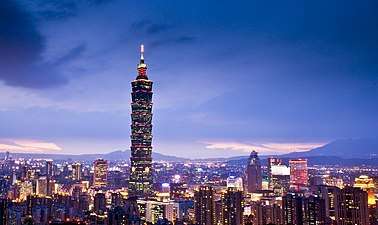 Taipei 101 at twilight
Taipei 101 at twilight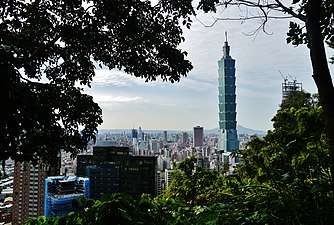 Taipei 101 from afar
Taipei 101 from afar- Taipei 101 viewed from below
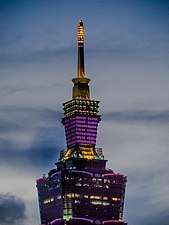 Tip of Taipei 101 illuminated on a Sunday night (purple)
Tip of Taipei 101 illuminated on a Sunday night (purple) Taipei 101 dominating the skyline at night
Taipei 101 dominating the skyline at night.jpg) Taipei 101 viewed from below
Taipei 101 viewed from below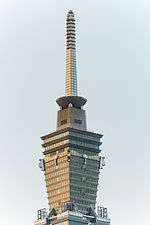 Tip of Taipei 101
Tip of Taipei 101 Taipei 101 next to Taipei Nan Shan Plaza
Taipei 101 next to Taipei Nan Shan Plaza- Entrance to Taipei 101 Observation Deck.
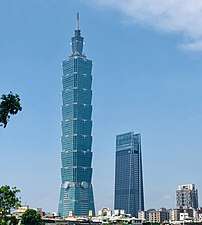 Taipei 101 next to Taipei Nan Shan Plaza
Taipei 101 next to Taipei Nan Shan Plaza.jpeg) Taipei 101 at sunset
Taipei 101 at sunset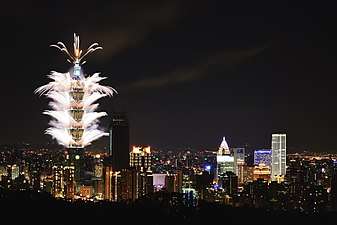 Taipei 101 New Year fireworks in 2016, with Taipei Nan Shan Plaza on the side, nearing completion.
Taipei 101 New Year fireworks in 2016, with Taipei Nan Shan Plaza on the side, nearing completion.
See also
- List of tallest buildings in Taiwan
- List of tallest buildings in Taipei
- Taipei Nan Shan Plaza
References
- "Taipei 101". CTBUH Skyscraper Center.. Retrieved 25 March 2015.
- Corporate Sustainability Report 2013. Taipei World Financial Center. Taipei. 2014.
- Taipei 101 at Emporis. Retrieved 25 March 2015.
- "Taipei 101, Taipei".
- "TAIPEI 101 – The Skyscraper Center". skyscrapercenter.com.
- "Taipei 101". findthedata.com. Archived from the original on 17 December 2015.
- "Taipei 101". SkyscraperPage.. Retrieved 25 March 2015.
- Taipei 101 at Structurae. Retrieved 25 March 2015.
- "World's fastest elevator: In Taiwan, the skyscraper's elevator travels at 60 km/h | Toronto Star". Toronto Star. Retrieved 8 March 2017.
- "Taipei 101 honored as world's tallest green building". Focus Taiwan News Channel. 29 July 2011.
- Seok-Hwai, Lee (10 August 2011). "World's Tallest Green Building". The Straits Times. Indonesia. Archived from the original on 30 October 2014. Retrieved 22 March 2015.
- "Height: The History of Measuring Tall Buildings". Council on Tall Buildings and Urban Habitat. December 2009.
- "Tallest Trends and the Burj Khalifa". Council on Tall Buildings and Urban Habitat. 10 March 2010.
- CTBUH Height Criteria. CTBUH. Retrieved 25 March 2015.
- CTBUH changes height criteria, Burj Dubai height increases. CTBUH. Retrieved 25 March 2015.
- Height: The History of Measuring Tall Buildings. CTBUH. Retrieved 25 March 2015.
- Taipei skyscraper deemed tallest. Associated Press. Paragraph abstract: The council measures from the sidewalk level of the main entrance to the skyscraper's architectural top.
- Ai-Li, Jian & Neng-You, Wang. 與天爭高,心意最重要 新光摩天大樓. 閱讀臺北. Department of Information and Tourism, Taipei City Government. April 2009, Vol. 486. (Chinese).
- List of skyscrapers in Taiwan. SkyscraperPage. Retrieved 25 March 2015.
- Taipei 101 countdown to lead New Year celebrations. China Post. 31 December 2003. Retrieved 25 March 2015.
- "Taiwan tops out tallest building". BBC News. 17 October 2003. Retrieved 24 May 2010.
- Observatory brochure, Floor 89, Taipei 101. 17 August 2007.
- "101 Taipei Financial Center Corp". taipei-101.com.tw.
- "The 728-Ton Tuned Mass Damper of Taipei 101".
- Publicly posted material, Floor 89, Taipei 101. 17 August 2007.
- Anal Sheth. Taipei 101, Taiwan. Structural Engineering Digest. Archived from the original on 4 April 2015. Retrieved 21 March 2015.
- VISCOUS DAMPERS FOR HIGH-RISE BUILDINGS . Indian Institute of Technologies. Retrieved 24 August 2015.
- CTOT commemorates Canada and Taiwan ingenuity . China Post. Retrieved 24 August 2015.
- Canadian wind dampers hold sway over world's tallest condos. The Canada Broadcasting Corporation. Retrieved 24 August 2015.
- Tuned Mass Damper. Taipei World Financial Center. Retrieved 25 March 2015.
- "Taipei 101" (PDF). Motioneering. Archived from the original (PDF) on 14 April 2010.
- "Damper at Taipei 101 records biggest movement ever". Focus Taiwan. Retrieved 9 August 2015.
- "How a Skyscraper Stays Upright in a Typhoon". Popular Mechanics. Retrieved 10 August 2015.
- "Taipei 101: Not the Tallest Building in the World, But Still Pretty Cool". Condé Nast Traveler.
- "The Asian Dream According to Taipei 101 and its Damper Babies ~ HAYPINAS.ORG: OVERSEAS FILIPINO CHANNEL". Archived from the original on 19 November 2015.
- Binder, Georges (2008). Taipei 101. Images Publishing. p. 82. ISBN 9781864702484.
- "Taipei 101". All About Skyscrapers. 2009. Archived from the original on 1 October 2011. Retrieved 15 April 2013.
- SnarkyNomad (26 December 2013). "Why Taipei 101 is the coolest skyscraper on the planet". Snarky Nomad. Retrieved 9 October 2015.
- Structuremag.org. Taipei 101 the worlds tallest building Archived 9 April 2008 at the Wayback Machine. 6 June 2005.
- "Taipei 101 to become world's tallest green building next year". Taiwan News. 1 April 2010. Retrieved 1 January 2016.
- Ang, Swee Hoon (1997). "Chinese consumers' perception of alpha-numeric brand names". Journal of Consumer Marketing. 14 (3): 220–233. doi:10.1108/07363769710166800.
- Steven C. Bourassa; Vincent S. Peng (1999). "Hedonic Prices and House Numbers: The Influence of Feng Shui". International Real Estate Review. 2 (1): 79–93. Archived from the original (PDF) on 13 April 2015.
- Duchaine, Julie; Hughes, Holly; Flippin, Alexis Lipsitz; Murphy, Sylvie (2010). Frommer's 500 Extraordinary Islands. Hoboken: John Wiley & Sons. ISBN 9780470595190.
- "Ru Yi at Feng Shui Bestbuy". fengshuibestbuy.com. Retrieved 1 January 2016.
- "Taipei 101: Reaching for The Sky". Internet Archive. Retrieved 9 October 2015.
- "New World's Tallest Building Completed in Taipei, Taiwan". San Jose Mercury News (San Jose, CA). 21 October 2003. Archived from the original on 5 January 2007. Retrieved 9 October 2015. – via HighBeam (subscription required)
- Lights Schedule. Taipei World Financial Center. Retrieved 25 March 2015.
- Lighting Timetable. Taipei World Financial Center. Retrieved 25 March 2015.
- Public signage placed at Taipei 101 clock.
- "Taipei 101, Bigger is not Better (台北101, 更大不等於更好)". Taiwan Design Center. 15 September 2004. Retrieved 17 September 2009.
- T for Two – Two Feng Shui Tips for T-Intersections.
- dreaded T-intersection and cul-de-sac.
- Edited by T. C. Kline, P. J. Ivanhoe (2000). Virtue, Nature, and Moral Agency in the Xunzi. Hackett Publishing Company, Inc. pp. 220–236. ISBN 9780872205222.CS1 maint: extra text: authors list (link)
- Graham Norris. Taking it to the Skies. Retrieved 25 March 2015.
- Observatory Floor Guide. Taipei World Financial Center. Retrieved 25 March 2015.
- Facts about Taipei 101. Taipei World Financial Center. Retrieved 25 March 2015.
- Popular Mechanics – World's Fastest Elevator Archived 12 October 2007 at the Wayback Machine.
- ArchitectureWeek – Taiwan On Top.
- Elevator World – Breaking the 1000MPM Barrier – High speed elevators in Taipei 101.
- TAIPEI 101 Observatory – Damper Baby – Wind Damper Archived 22 April 2018 at the Wayback Machine. Taipei World Financial Center. Retrieved 25 March 2015.
- Keith Bradsher. Taiwan Close to Reaching a Lofty Goal. The New York Times. 11 January 2004. Retrieved 25 March 2015.
- 85F Restaurant. Taipei World Financial Center. Retrieved 25 March 2015.
- "Taipei 101 to open top floor to public for the first time".
- "Taipei: The End". Blade-edge.com. Retrieved 12 June 2011.
- "Mystery Solved". Ozsoapbox.com. Retrieved 1 April 2014.
- Jenni Marsh; Jane Sit (6 October 2016). "Which 3 Guinness World Records did the Shanghai Tower just win?". CNN. Retrieved 8 March 2017.
- "Hitachi reaches 1,260 m/min, the World's Fastest*1 Speedwith Ultra-High-Speed Elevator" (PDF). Retrieved 17 October 2019.
- 【台北101】101樓揭密 – 戴心怡主播、蔣心玫採訪 (2013/9/9). 10 September 2013 – via YouTube.
- Exploring Taipei – The heights, lights and sights of Taipei, Taiwan. Travel magazine. Retrieved 25 March 2015.
- Jackie Lin. Shin Kong Tower Observatory to close by year-end. The Taipei Times. 25 September 2013. Retrieved 25 March 2015.
- Floor Guide. Taipei World Financial Center. Retrieved 25 March 2015.
- Observatory Visit Information. Taipei World Financial Center. Retrieved 25 March 2015.
- "Taipei 101's top floor opens to public for first time". TaiwanNews.com. Retrieved 9 July 2019.
- 101季刊 eNewsletter. Taipei World Financial Center. Retrieved 25 March 2015.
- Taipei 101 Mall thronged on opening day Archived 17 September 2016 at the Wayback Machine. Taiwan: Ministry of Foreign Affairs (Taiwan). 21 March 2003. Retrieved 25 March 2014.
- Stacy Hsu. New building may put an end to the Taipei 101 New Year's Eve fireworks. The Taipei Times. 25 September 2013. Retrieved 25 March 2015.
- New year ushered in by having a blast Archived 17 September 2016 at the Wayback Machine. Ministry of Foreign Affairs (Taiwan). 7 January 2005. Retrieved 25 March 2015.
- Chen, Melody (1 March 2005). "Clinton praises Taiwan's leaders during brief visit". The Taipei Times. Retrieved 10 November 2014.
- 'Spiderman' scales tallest tower". BBC News. 25 December 2005.
- "Base jumper survives leap off worlds tallest building". The Times. London. 13 December 2007. Retrieved 24 May 2010.
- German wins race up world's tallest skyscraper Archived 20 May 2011 at the Wayback Machine. Agence France-Presse.
- Inquirer – German wins race up world's tallest skyscraper Archived 16 June 2008 at the Wayback Machine.
- "HKT48 台北ライブの前夜祭を台北101・91Fの展望台で開催!". ライブドアニュース (in Japanese). Retrieved 15 November 2017.
- "Facts of Taipei 101, the former World's Tallest Building". The Tower Info. Retrieved 15 November 2017.
- News, Taiwan. "Taipei 101 New Year's Eve fireworks displ..." Taiwan News. Retrieved 22 February 2020.
- Etaiwannews.com.
- LEED certified: The tallest "green" building in the world. Siemens Building Technologies.
- "Taipei 101 to become world's tallest green building in Q3". Focus Taiwan News Channel. 15 January 2011. Retrieved 15 January 2011.
- "Taipei 101 receives top certification from green rating council". The Taipei Times. 29 July 2011. Retrieved 28 July 2011.
- "Magazine digest – Chinese business helps Taipei 101 turn profit". Focus Taiwan News Channel. 18 January 2011. Retrieved 24 January 2011.
External links
| Wikimedia Commons has media related to Taipei 101. |
- 2013 Taipei 101 New Year Fireworks
- Taipei 101 Official Website
- Taipei 101 Official Website – Observatory
- Taipei 101 Official Website – Mall
- YouTube – Taipei 101 New Year Fireworks 2005, 2006, 2007, 2008
- National Geographic Channel – Richard Hammond examines Taipei 101
- Consulting services by RWDI (wind engineering and emergency ventilation) and Motioneering (tuned mass damper)
- Megastructure Supports Taipei's 508-Meter 'Megatower' by Engineering News-Record, a weekly magazine by McGraw-Hill Construction of McGraw-Hill
- LEED Official Site
- C. Y. Lee Architects Office Official Website

| Records | ||
|---|---|---|
| Preceded by Petronas Towers 451.9 m (1,483 ft) |
World's tallest building 509.2 m (1,671 ft) 2004–2010 |
Succeeded by Burj Khalifa 828 m (2,717 ft) |
| Preceded by Willis Tower 442 m (1,450 ft) & 412.4 m (1,353 ft) |
World's highest roof & highest occupied floor 449.2 m (1,474 ft) & 439.2 m (1,441 ft) 2003–2008 |
Succeeded by Shanghai World Financial Center 492 m (1,614 ft) & 474 m (1,555 ft) |
| Preceded by Yokohama Landmark Tower 12.5 m/s (41 ft/s) (45 km/h, 28 mi/h) |
World's fastest elevator 16.83 m/s (55.22 ft/s) (60.6 km/h, 37.7 mi/h) 2003–2016 |
Succeeded by Shanghai Tower 20.5 m/s (67.26 ft/s) (73.8 km/h, 45.9 mi/h) |
| Preceded by Tuntex Sky Tower 347.5 m (1,140 ft) |
Tallest building in Taiwan 509.2 m (1,671 ft) 2004–present |
Incumbent |
| Preceded by Bank of America Tower |
World's tallest & highest-use green building (LEED platinum rating) 2011–present | |
| Preceded by Environmental Protection Agency building (Florida, U.S.) |
World's largest green building (LEED platinum rating) 2011–present | |
| Preceded by Unknown |
World's largest & heaviest wind damper diameter 5.5 m (18 ft) & 660 metric tons (728 short tons) 2003–present | |

